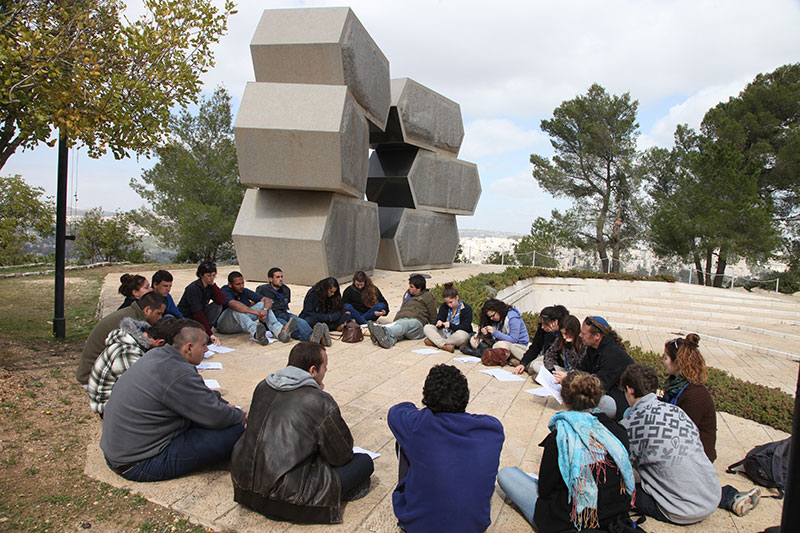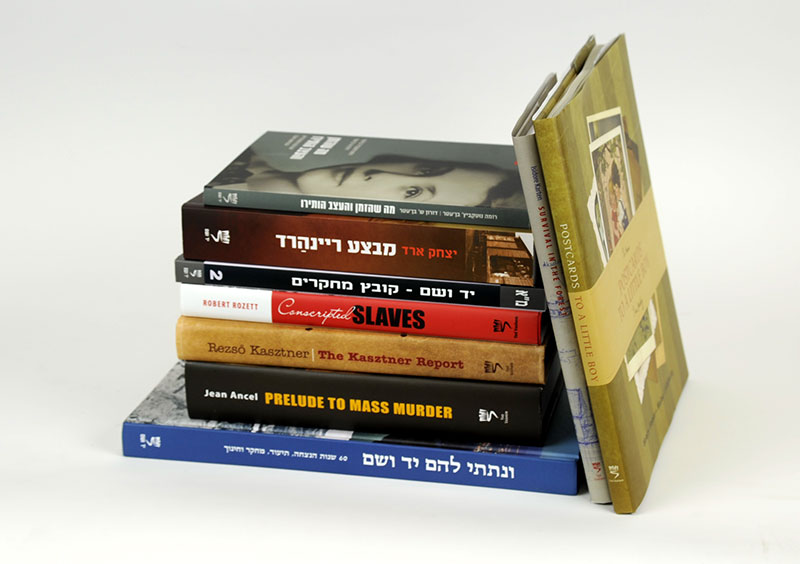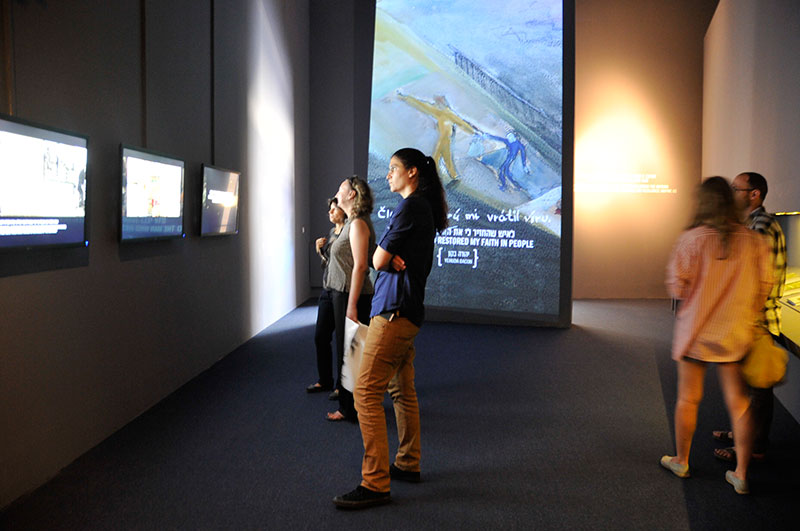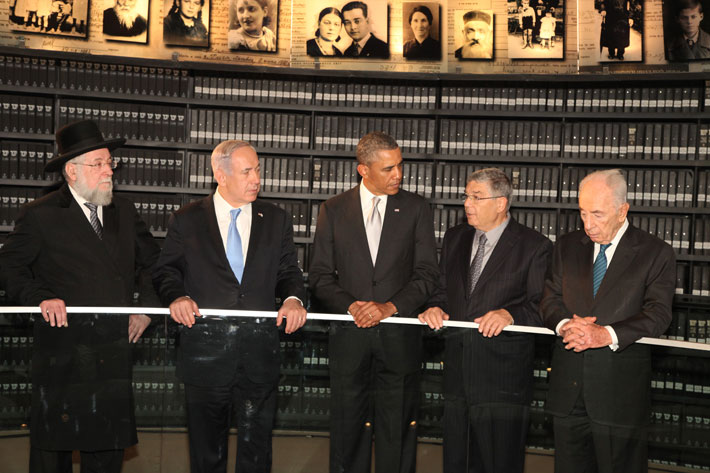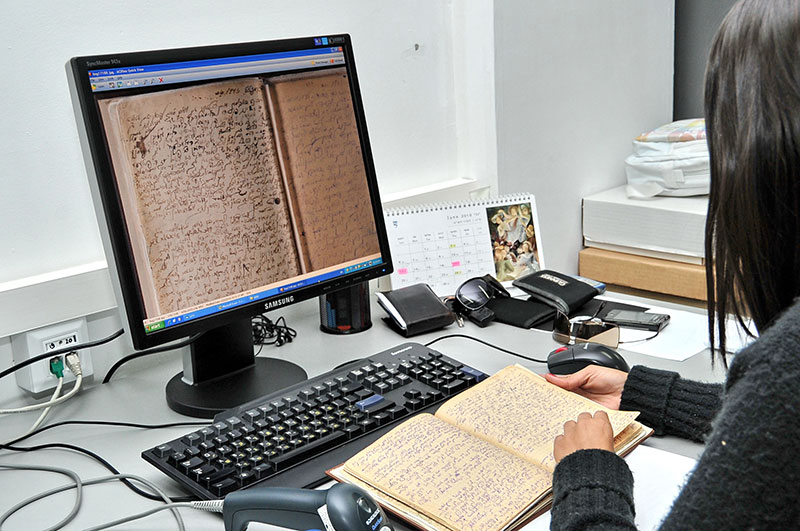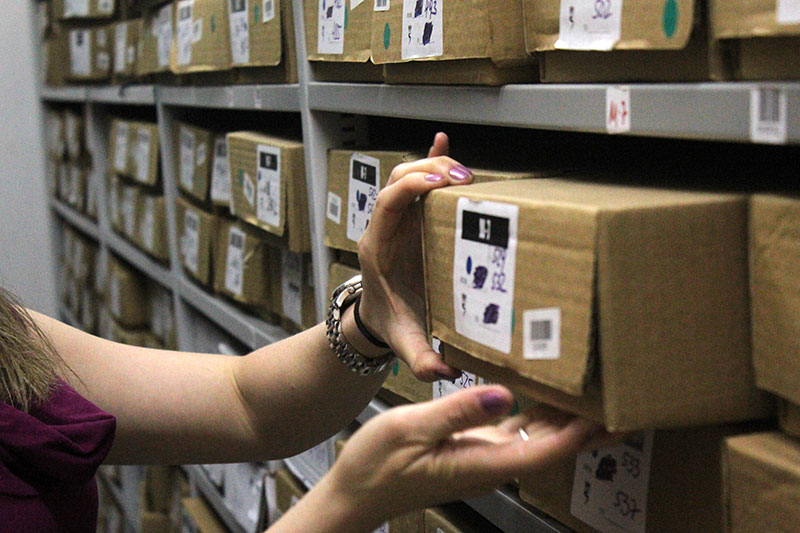The new Permanent Exhibition "Shoah"
The exhibition designed, built and curated by Yad Vashem, opened in Block 27 at the Auschwitz-Birkenau State Museum.
Holocaust Education – The International School
- More than 306,000 students from Israel and abroad, soldiers and officers of the IDF and other Israeli security forces participated in seminars and programs of the International School for Holocaust Studies and at the School’s branch in Givatayim. Of those, more than 74,000 were Jewish students from overseas.
- 63 long-term seminars were held at Yad Vashem for more than 1,460 educators from abroad. Some 70 youth participated in 4 International courses for Jewish leadership.
- 92 seminars were conducted for some 3,000 Israeli teachers.
- Some 1,150 foreign educators participated in 57 teacher-training days at the School.
- 95 school staff members, together with School graduates around the world, participated in seminars, conferences and international forums and worked in some 34 different countries worldwide.
- More than 10,000 Israeli educators attended 334 teacher-training days at Yad Vashem and throughout Israel. Among these were more than 3,500 ultra-Orthodox teachers.
- More than 1,000 ultra-Orthodox teachers participated in 3 special teacher-training days for ultra-Orthodox educators at Yad Vashem.
- Some 1,200 teachers from across Israel participated in the 5th National Teachers' Conference.
- More than 3,000 teachers across the US received training as part of “Echoes and Reflections,” a joint project of Yad Vashem, the ADL and the USC Shoah Foundation Institute. More than 20,000 educators and community leaders have been trained since the inception of the program.
- An extensive range of educational material in 15 different languages was uploaded to the Virtual School on the Yad Vashem website, including the new Holocaust Education Video Toolbox. The Toolbox currently includes 6 films, totaling 70 minutes of video, divided into succinct chapters, as well as an accompanying mini-site.
- More than 740 individuals participated in online courses conducted in 6 languages. Also added to the website were lesson plans and sub-sites for special events, including curricula marking special occasions such as Holocaust Remembrance Day and International Holocaust Remembrance Day.
- 250 participants attended international video conferences. 10 online newsletters in 3 languages were disseminated; 5 online courses were updated to advanced and interactive learning platforms; 36 mini-sites that accompanied Israeli teacher-training courses were uploaded; 34 projects by School graduates from various countries have been uploaded to the Virtual School in 9 languages, deepening the connection between graduates.
Research and Publications
- The International Institute for Holocaust Research granted the third annual Yad Vashem International Book Prize for Holocaust Research in memory of Abraham Meir Schwarzbaum, Holocaust survivor, and his family members murdered in the Holocaust. The 2013 recipients were Dr. Avihu Ronen for his book, Condemned to Life: The Diaries and Life of Chajka Klinger (University of Haifa and Yedioth Books, 2011) and to Prof. Bernard Wasserstein for his book, On the Eve: The Jews of Europe Before the Second World War (London: Profile Books, 2012).
- The International Institute for Holocaust Research held 2 international research workshops and 27 workshops for Holocaust scholars, as well as the annual lecture of The John Najmann Chair of Holocaust Studies, and an international conference in partnership with the Western Galilee College and Ghetto Fighters' House.
- 12 senior researchers from Israel and abroad were hosted at Yad Vashem as postdoctoral fellows and 2 as research fellows under the auspices of the EHRI program.
- The Institute granted 13 awards to Master's and Doctoral students studying in Israel and 2 awards to Doctoral students studying abroad.
- 36 new publications were released by Yad Vashem, including 13 research studies, 5 memoirs, 11 diaries, 4 volumes of Yad Vashem Studies, 2 albums, and The Encyclopedia of the Ghettos in German (2 volumes).
Artworks and Artifacts
- A new exhibition "I Am My Brother's Keeper: 50 Years of Honoring Righteous Among the Nations" opened in the Exhibitions Pavilion.
- Traveling exhibitions were displayed in 9 countries worldwide. 41 versions of 13 exhibitions are now available in 13 languages: English, French, German, Spanish, Flemish, Ukrainian, Russian, Portuguese, Finnish, Latvian, Italian, Greek and Arabic.
- 1,670 artifacts and 200 works of art were added to Yad Vashem’s collections. The artifacts collection now holds some 27,500 items and the Art Collection comprises more than 9,100 pieces.
Righteous Among the Nations
- 454 individuals were recognized as Righteous Among the Nations. As of the end of 2013, more than 25,270 individuals have been awarded the title.
Visits and Commemorative Events
- Some 900,000 people visited Yad Vashem in 2013.
- 800 world leaders, dignitaries and official visitors toured Yad Vashem.
- The Commemoration and Public Relations Division held some 80 events, including the Holocaust Remembrance Day and VE Day ceremonies and more than 290 memorial services in conjunction with Holocaust survivor and next-generation organizations.
Internet Activity
- More than 13.6 million visits from some 220 countries and territories were recorded in 2013 on the Yad Vashem website.
- Over 8.1 million video views have been recorded on Yad Vashem's YouTube channels in English, Hebrew, Spanish, Farsi, Russian, Arabic and German since their launch.
- More than 25,700 individuals have joined Yad Vashem's Facebook page, bringing the total number of members to more than 73,100.
- More than 4,600 individuals became new followers of Yad Vashem on Twitter. More than 7,200 people now follow the Twitter feed.
- Yad Vashem's website won the "People and Computers" Magazine's Special Category Webi Award.
Documentation, Photographs, Names, Testimonies and Films
- Some 15 million pages of Holocaust-era documentation were gathered by Yad Vashem. To date, Yad Vashem’s Archives, the largest and most comprehensive repository of its kind, contain some 169 million pages of documentation.
- More than 2 million pages of original Holocaust documentation and some 15 million pages of microfilmed documentation were digitized.
- The Archives operated an Israeli national center for the digital backup of Holocaust documentation. In 2013, the center scanned and provided digital backup for some 200,000 pages of documentation held at 3 leading Holocaust archives in Israel.
- Yad Vashem has identified some two-thirds of the victims of the Holocaust. The Central Database of Shoah Victims’ Names now contains 4.3 million names of Holocaust victims, all of which are accessible online. The source of close to half the total number of names in the Names Database is over 2.6 million Pages of Testimony while the remainder is from archival lists and documents.
- The Shoah Victims' Names Recovery Project gathered 154,500 names, some 29,000 from Pages of Testimonies. The Names Recovery Project utilizes a network of volunteers around the world (organizations and individuals) to collect names of Holocaust victims. Its focus is on the missing names from the FSU and from the ultra-Orthodox community, and Jewish commemorative sources: religious books, memorial plaques, and the tombstones of survivors upon which are engraved the names of their family members who were murdered in the Holocaust.
- The Gathering the Fragments campaign to rescue personal items from the Holocaust era collected more than 33,000 items – documents, diaries, photographs, artifacts and artworks – from some 1,300 individuals in 28 centralized collection days and 270 home collections. Since the project was launched in April 2011, more than 104,000 items have been received from 5,800 individuals.
- Some 7,000 photographs were added to the Photo Archive, and some 3,100 to the Hall of Names. Yad Vashem currently houses some 430,000 photographs, including some 148,000 photographs attached to Pages of Testimony.
- Some 288,000 photographs are easily accessible to the general public on the Yad Vashem website. Of these, 140,000 historical photographs are available on a new interface and some 148,000 are attached to Pages of Testimony and accessible on the Central Database of ShoahVictims’ Names.
- Some 1,000 new Holocaust survivor testimonies were filmed and recorded by the Oral History Section, Archives Division, aided by an outreach program enabling survivors to have their testimonies filmed at home, and some additional 7,000 testimonies recorded elsewhere were acquired. The Archives currently house some 120,000 video, audio and written testimonies.
- Some 31,000 public inquiries were answered by the Reference and Information Services Unit. Of these inquiries, 10,000 members of the public were assisted in the Library and Archives Reading Room, and over 21,000 were written queries.
- Yad Vashem's Library, the most comprehensive collection of published material about the Holocaust, now holds over 141,000 titles in 54 languages.
- The Visual Center acquired more than 500 films, including classics from the past as well as new films, and catalogued more than 500 from a variety of genres. The total number of catalogued films has reached more than 8,500. Currently over half of these titles, some 6,000 films, are available for viewing at the Visual Center.
- In addition to thousands of visitors to the Visual Center, more than 50 groups of students, teachers and film directors took part in Holocaust-related film programs, including lectures on film and the Holocaust. The Visual Center held special screenings of films for the general public and in conjunction with the 13th Animax Film festival for comics and animation at the Tel Aviv Cinematheque, the Jewish Film Festival at the Jerusalem Cinematheque as well as at commemorative events and film festivals in Israel and around the world.
- The Visual Center Staff responded to some 1,000 public inquiries for research and information regarding the cinema and the Shoah.
- The Visual Center granted the eighth annual Avner Shalev Yad Vashem Chairman’s Award to director Wladyslaw Pasikowski for his film Aftermath. The annual award is presented for artistic achievement in Holocaust-related film.




